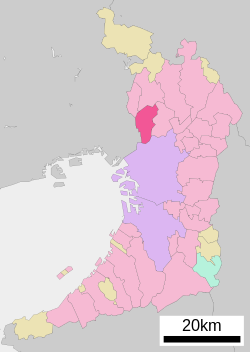Toyonaka
 From Wikipedia - Reading time: 11 min
From Wikipedia - Reading time: 11 min
Toyonaka
豊中市 | |
|---|---|
 Toyonaka City Hall | |
 Location of Toyonaka in Osaka Prefecture | |
 | |
| Coordinates: 34°47′N 135°28′E / 34.783°N 135.467°E | |
| Country | Japan |
| Region | Kansai |
| Prefecture | Osaka |
| Government | |
| • Mayor | Shigeki Osanai (from May 2018) |
| Area | |
• Total | 36.39 km2 (14.05 sq mi) |
| Population (May 1, 2023) | |
• Total | 399,263 |
| • Density | 11,000/km2 (28,000/sq mi) |
| Time zone | UTC+09:00 (JST) |
| City hall address | 3-1-1 Nakasakurazuka, Toyonaka-shi, Osaka-fu 561-8501 |
| Climate | Cfa |
| Website | Official website |
| Symbols | |
| Flower | Rose |
| Tree | Sweet Osmanthus |

Toyonaka (豊中市, Toyonaka-shi) is a city in Osaka Prefecture, Japan. As of 1 May 2023[update], the city had an estimated population of 399,263 in 179651 households and a population density of 5700 persons per km2.[1] The total area of the city is 36.39 square kilometres (14.05 sq mi). It is a suburban city of Osaka City and a part of the Kyoto-Osaka-Kobe metropolitan area.
Geography
[edit]Toyonaka is located in northern Osaka Prefecture. Topographically, the northern part is high (facing the Senri Hills), and the southern part is low (facing the Osaka Plain). A gently sloping terrace of 20 to 50 meters above sea level distributed on the western edge of the city is called the Toyonaka Plateau, which forms the center of the urban area. With the exception of the buffered green zone around Osaka International Airport, the area of Toyonaka is almost urbanized.
Neighboring municipalities
[edit]Osaka Prefecture
Demographics
[edit]| Year | Pop. | ±% |
|---|---|---|
| 1950 | 102,304 | — |
| 1955 | 127,678 | +24.8% |
| 1960 | 199,065 | +55.9% |
| 1965 | 291,936 | +46.7% |
| 1970 | 368,498 | +26.2% |
| 1975 | 398,384 | +8.1% |
| 1980 | 403,174 | +1.2% |
| 1985 | 413,213 | +2.5% |
| 1990 | 409,837 | −0.8% |
| 1995 | 398,908 | −2.7% |
| 2000 | 391,726 | −1.8% |
| 2005 | 386,623 | −1.3% |
| 2010 | 389,359 | +0.7% |
| 2015 | 395,479 | +1.6% |
| 2020 | 401,558 | +1.5% |
| Toyonaka population statistics[2] | ||
Climate
[edit]Toyonaka has a Humid subtropical climate (Köppen Cfa) characterized by warm summers and cool winters with light to no snowfall. The average annual temperature in Toyonaka is 16.4 °C (61.5 °F). The average annual rainfall is 1,326.3 mm (52.22 in) with July as the wettest month. The temperatures are highest on average in August, at around 28.7 °C (83.7 °F), and lowest in January, at around 5.1 °C (41.2 °F).[3]
| Climate data for Toyonaka (1991−2020 normals, extremes 1977−present) | |||||||||||||
|---|---|---|---|---|---|---|---|---|---|---|---|---|---|
| Month | Jan | Feb | Mar | Apr | May | Jun | Jul | Aug | Sep | Oct | Nov | Dec | Year |
| Record high °C (°F) | 18.8 (65.8) |
22.2 (72.0) |
23.4 (74.1) |
30.8 (87.4) |
33.2 (91.8) |
37.9 (100.2) |
39.5 (103.1) |
39.9 (103.8) |
37.3 (99.1) |
33.9 (93.0) |
26.3 (79.3) |
23.7 (74.7) |
39.9 (103.8) |
| Mean daily maximum °C (°F) | 9.6 (49.3) |
10.4 (50.7) |
14.1 (57.4) |
19.9 (67.8) |
25.0 (77.0) |
28.1 (82.6) |
31.8 (89.2) |
33.8 (92.8) |
29.6 (85.3) |
23.8 (74.8) |
17.8 (64.0) |
12.1 (53.8) |
21.3 (70.4) |
| Daily mean °C (°F) | 5.1 (41.2) |
5.7 (42.3) |
9.1 (48.4) |
14.5 (58.1) |
19.5 (67.1) |
23.3 (73.9) |
27.4 (81.3) |
28.7 (83.7) |
24.7 (76.5) |
18.7 (65.7) |
12.7 (54.9) |
7.4 (45.3) |
16.4 (61.5) |
| Mean daily minimum °C (°F) | 0.7 (33.3) |
1.0 (33.8) |
4.0 (39.2) |
9.1 (48.4) |
14.3 (57.7) |
19.3 (66.7) |
23.8 (74.8) |
24.8 (76.6) |
20.7 (69.3) |
14.2 (57.6) |
7.8 (46.0) |
2.8 (37.0) |
11.9 (53.4) |
| Record low °C (°F) | −5.8 (21.6) |
−6.3 (20.7) |
−3.7 (25.3) |
−0.4 (31.3) |
4.6 (40.3) |
9.9 (49.8) |
15.7 (60.3) |
17.3 (63.1) |
10.8 (51.4) |
3.9 (39.0) |
0.0 (32.0) |
−4.5 (23.9) |
−6.3 (20.7) |
| Average precipitation mm (inches) | 44.4 (1.75) |
59.3 (2.33) |
97.1 (3.82) |
98.2 (3.87) |
137.4 (5.41) |
180.1 (7.09) |
182.6 (7.19) |
122.8 (4.83) |
159.2 (6.27) |
127.1 (5.00) |
68.5 (2.70) |
49.6 (1.95) |
1,326.3 (52.22) |
| Average precipitation days (≥ 1.0 mm) | 5.4 | 6.2 | 9.2 | 8.8 | 9.7 | 11.1 | 10.6 | 7.2 | 9.9 | 8.5 | 5.8 | 6.0 | 98.4 |
| Source: Japan Meteorological Agency[4][3] | |||||||||||||
History
[edit]The area of Toyonaka was part of ancient Settsu Province. The village of Toyonaka was established with the creation of the modern municipalities system on April 1, 1889. It was raised to town status on April 1, 1927, and to city status on October 15, 1936. On April 1, 2001, Toyonaka was designated a Special city with increased local autonomy. It was further promoted to a core city on April 1, 2012.
Government
[edit]Toyonaka has a mayor-council form of government with a directly elected mayor and a unicameral city council of 34 members. Toyonaka contributes four members to the Osaka Prefectural Assembly. In terms of national politics, the city is part of Osaka 8th district of the lower house of the Diet of Japan.
Economy
[edit]Toyonaka is a regional commercial center and distribution hub for Osaka. Due to its proximity to the Osaka metropolitan area, it is also a commuter town, and includes Senri New Town and other large-scale housing developments. Manufacturing industry is concentrated in the south. Economically, the city has a long-standing relationship with Hankyu Corporation. Therefore, many of the core companies of the Hankyu and Hanshin group are headquartered in Toyonaka.
Education
[edit]Toyonaka has 41 public elementary schools and 17 public middle schools operated by the city government and five public high school operated by the Osaka Prefectural Department of Education. There are also one private elementary school, one private middle school and four private high schools. The prefecture also operates two special education schools for the handicapped. The Osaka College of Music is located in Toyonaka.
Transportation
[edit]Airports
[edit]Osaka International Airport is partially located in Toyonaka including its terminal, although it is more commonly associated with the city of Itami.
Railway
[edit]![]() Hankyu Railway Hankyu Takarazuka Line
Hankyu Railway Hankyu Takarazuka Line
- Shōnai - Hattori-tenjin - Sone - Okamachi - Toyonaka - Hotarugaike
Highway
[edit] Chūgoku Expressway
Chūgoku Expressway Meishin Expressway
Meishin Expressway Hanshin Expressway Route 11 Ikeda Route
Hanshin Expressway Route 11 Ikeda Route National Route 171
National Route 171 National Route 176
National Route 176 National Route 423
National Route 423 National Route 479
National Route 479
Sister cities
[edit] San Mateo, California, United States[5]
San Mateo, California, United States[5]
The Consulate-General of Russia in Osaka is located in Toyonaka.[6]
Local attractions
[edit]- Harada Shrine. Founded during the reign of the Emperor Tenmu (672–686), the wooden shrine was rebuilt in 1652 and again in 1781. An important cultural property, it is known for its copse of camphor trees and it is the site of the popular Lion Festival each October.[7]
- Hattori Ryokuchi Arboretum
- Hattori Ryokuchi Park
- Open-Air Museum of Old Japanese Farm Houses
- Osaka University
Notable people from Toyonaka
[edit]- Shōzō Endō, comedian
- Takashi Fujii, television performer
- Mai Hosho, actress [8]
- Tak Matsumoto, musician and guitarist (B'z)
- Yoshihiro Murai, governor of Miyagi prefecture (2005–present)
- Yukie Nishimura, pianist and composer
- Masashi Oguro, soccer player
- Panchan Rina, kickboxer
- Unagi Sayaka, professional wrestler
- Kaoru Shintani, manga artist
- Sanshiro Takagi, professional wrestler
- Naoki Tanaka, comedian
- Naoki Tanizaki, professional wrestler
- Osamu Tezuka, manga artist and animator
- Hitomi Yaida, singer and songwriter
References
[edit]- ^ "Toyonaka city official statistics" (in Japanese). Japan.
- ^ Toyonaka population statistics
- ^ a b 気象庁 / 平年値(年・月ごとの値). JMA. Retrieved April 12, 2022.
- ^ 観測史上1~10位の値(年間を通じての値). JMA. Retrieved April 12, 2022.
- ^ "San Mateo and Toyonaka Celebrate 50 Years" in the 2013 Late Summer Edition Archived June 30, 2014, at the Wayback Machine of the San Mateo City Newsletter. Retrieved on February 18, 2016.
- ^ "List of Consulates in Kansai Area Archived 2008-09-23 at the Wayback Machine." Creation Core Higashi Osaka. Retrieved on January 15, 2009.
- ^ http://www.nihon-kankou.or.jp.e.wp.hp.transer.com/osaka/detail/27203ba2212055492 [dead link]
- ^ 株式会社スポーツニッポン新聞社マルチメディア事業本部. 宝生舞 ~タレント名鑑~ ― スポニチ Sponichi Annex 芸能. www.sponichi.co.jp (in Japanese). Retrieved 2016-02-20.
External links
[edit]- Official website (in Japanese)
 KSF
KSF

